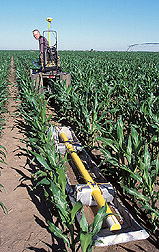This page has been archived and is being provided for reference purposes only. The page is no longer being updated, and therefore, links on the page may be invalid.
|
Read the magazine story to find out more. |
Using Electromagnetic Induction to Trace Soil NitrogenBy David ElsteinSeptember 16, 2004 Nitrogen, a chemical nutrient needed by many growing crops, can accidentally end up in surface or subsurface water. Now an Agricultural Research Service scientist is using electromagnetic induction (EI) to measure changes in the soil's electrical conductivity, a quality that can provide important clues to the amount of nutrients present in the soil. Roger A. Eigenberg is an agricultural engineer at the ARS Roman L. Hruska U.S. Meat Animal Research Center in Clay Center, Neb. He has used EI to study several fields and create a map with light-shaded areas representing high electrical conductivity--or areas of high nitrate concentration--and dark areas that indicate low conductivity, or low nitrate concentration. Eigenberg has compared fields with and without a winter cover crop and fields with added manure or compost. He discovered that EI could be used to monitor the effects of winter cover crops, because EI changes corresponded to soil nutrient changes as the cover crop took up nutrients in the fall and released them back to the soil in the spring. Another Clay Center research location was a former manure compost site. In the past, scientists had to take numerous soil samples to determine where manure rows had been located. Using the commercially available EI equipment, Eigenberg was able to locate them in a fraction of the time. He tracked nutrient movement over a four-year period and found that using equipment such as the EI meter can determine nutrient buildup and movement to help prevent nitrate leaching into groundwater. More details about this research are published in the September 2004 issue of Agricultural Research magazine. ARS is the U.S. Department of Agriculture's chief scientific research agency. |

